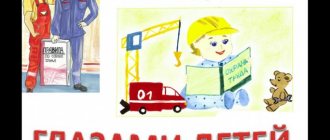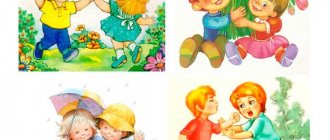“Book Week” in the senior group: planning
It is impossible to overestimate the impact that reading books has on literacy, replenishment of vocabulary, and expansion of a person’s horizons, especially in children at the preparatory stage of development.
“Book Week” at the preschool educational institution
For your information! It is easiest to develop an interest in new things in childhood, since children have the ability to vividly and sincerely experience, sympathize, rejoice, and be indignant, which manifests itself while reading a work of art.
Goals, objectives
The main goal of this project is to instill a love for reading books, teach children to respect them, and develop an interest in books through creative and educational activities.
During the implementation of this project, the following tasks are envisaged:
- To generate and maintain an interest in books and a love of reading, to cultivate a reader's taste and respect for books.
- Give children an idea of the types of books and literary genres.
- Familiarize children with all stages of book creation.
- To develop in children an understanding of the role of the writer, illustrator, and designer in the creation of a book.
- Explain to students the need and importance of libraries.
- Involve children, parents, and teachers in playing out stories from books.
Introducing kids to nature
Lexical topics
Every day of the calendar week it is planned to hold events (games, activities), presentations (speaking out abstracts and publishing notes in class) or thematic classes (communicating important information on a specific topic) on the following lexical topics:
- Monday. A walk around the native land. Acquaintance with nature through the works of writers Bianchi V.V., Prishvin M.M.
- Tuesday. Tanya, Yulechka, Petya and other heroes. Acquaintance with children's poetry through the works of Marshak S. Ya., Mikhalkov S. V., Agnia Barto, Tokmakova I. P., Mustai Karim.
- Wednesday. Travel to Buyan Island. Acquaintance with fairy tales and fables through the works of Pushkin A.S., Krylov I.A., Ushinsky K.D.
- Thursday. Walking around St. Petersburg. Acquaintance with the architecture, geography, life, climate of St. Petersburg through the poems of the poets A. A. Blok, Sasha Cherny.
- Friday. The Adventures of Bibigon. Acquaintance with the works of the writer Chukovsky K.I.
- Saturday. Dunno's friends. Acquaintance with the works of the writer N. N. Nosov.
Additional Information! Within each topic, children should be introduced to the biography and famous works of children's writers and poets, and a general description of their work should be given. Choose one of the plots in the works that most captivated the children, and role-play it with them.
Final event
The final event is that you should set aside time every day to make a book of your own composition and with drawings. At the end of Book Week, there will be an exhibition of books made by the children themselves.
Important! All events within the framework of Book Week must comply with federal state educational standards (FSES).
Training and simulators for reading by syllables for preschoolers
Baby book made from A4 paper
Little baby books are great for learning the basics of reading. They are cheerful and funny, there is nothing superfluous in them, and the child perceives such leisure time as an exciting game. And such pocket books are always convenient to take with you on trips and travels!
Photo: pinterest.ru
You will need:
A4 paper, a stationery knife, glue, colored pencils, markers, pens and crayons.
How to do:
Fold a sheet of A4 paper in half lengthwise, then again crosswise, and again each half. Unfold it and make a cut in the middle with a utility knife. Coat one side with glue along the entire plane and fold the book, fixing the pages.
You can combine several of these paper blocks into one thicker book and even make a cover. All that remains is to draw pictures and write text. They can be used to study the seasons, animals, surrounding objects, numbers - anything!
Progress of the event
Main part:
Social teacher Yulia Aleksandrovna Potekhina comes to the group sites in the afternoon, when parents pick up parents from kindergarten, and addresses them with questions.
- Hello! My name is Yulia Aleksandrovna, I work as a social teacher. For a year now we have been introducing your children to human rights and their responsibilities. From March 25 to 28, Children's Book Week was held in the kindergarten. And from April 3 and 4 in our kindergarten we are holding a lottery for parents of preschool educational institutions on the topic “Artworks and Human Rights”, the purpose of which is to show the importance and significance of the legal direction in the social pedagogy of preschool educational institutions for parents of preparatory groups.
— Do you want to take part in the lottery called “Artworks and Human Rights”? Have you read the announcement? (Appendix No. 1) Are you familiar with the rules?
- No.
- Okay, now I’ll remind you of the rules.
The lottery is free. Lottery participants draw tickets (Appendix No. 2). Participants answer questions by drawing a lottery ticket. Starting only from the first level - this is the question that is on the yellow ticket. After answering the first question, the participant takes the second and third tickets. You can answer only one question of each level, no more. The participant who answers correctly receives a prize. Namely:
- the first level receives a pen;
- second level – corner folder;
- third level - a book from the series “We read for ourselves, we read for mom.”
The participant who gave the wrong answer must name and write down on the sheet of incorrect answers a favorite book or work that his child likes to listen to, leaf through, and look at (Appendix No. 3).
- Tonight you will definitely read this book that you won in our lottery.
— Dear parents! We pull out pieces of paper with questions and answer them. For the correct answer you receive a book for your child. We answer questions, take your time, think carefully about your answer.
— Thank you for participating in the lottery.
Awarding prizes. Conducting a sociological survey on the topic of the event.
Social survey questions after answers to lottery questions (Appendix No. 6) and answers to sociological survey questions, with percentages (Appendix 7).
After the lottery:
The lottery is held by a social teacher with parents of children in pre-school groups. Dads, mothers and grandmothers, in the amount of 20 people, took part in the lottery. 15 people answered all the lottery questions correctly:
- for the first question – 15 people,
- for the second – 18 people,
- for the third – 20 people.
Incorrect answers: 7.
Wanted to take part in a similar kindergarten event: 19 people - 95% of respondents.
Appendix No. 2
First level:
- What is the name of the main document on the rights of the child adopted at the 44th session of the UN General Assembly? (Convention on the Rights of the Child)
- In what year was the Convention on the Rights of the Child adopted? (1989)
- How many articles does the Convention on the Rights of the Child include? (54)
- In what year did Russia ratify the Convention on the Rights of the Child? (1990)
- In what year was the Universal Declaration of Human Rights adopted? (1948)
- At what age is a person considered a child, according to the UN? (0-18 years)
- To whom does the Convention give primary responsibility for raising a child? (for parents)
- Name the Polish writer who published the book “The Child’s Right to Respect” in 1929? (Janusz Korczak)
- Is raising a child a right or a responsibility of parents? (Both right and duty)
- Who owns the words that “the happiness of the whole world is not worth one tear on the cheek of an innocent child”? (F.M. Dostoevsky)
- Who is responsible for raising a child if the parents divorce? (Both parents)
Second level:
- Why did the inhabitants of the courtyard in Andersen's fairy tale "The Ugly Duckling" offend the ugly duckling? (He was not like the others.)
- Who violated the right to inviolability of home in the fairy tale “Zayushkina’s Hut”, and who helped the hare restore his rights? (Fox, Rooster)
- How far could the frog move using its right to freedom of movement? (No limits)
- What crime did the geese-swans commit in the fairy tale of the same name by stealing their brother? (Child abduction)
- What are the fairy tales in which the right to work was violated? (“Cinderella”, “Moroz Ivanovich”, “Thumbelina”)
- Do you think a child has a right to his opinion? (Yes, sure)
- What is the name of the profession of a person who exercises the right to medical care? (Doctor)
- What do you know about your name? (Name designation and translation)
- In which fairy tales is the right to privacy of home violated? Name them. (“Three Bears”, “Three Little Pigs”, “Zayushkina’s Hut”, “Little Red Riding Hood”)
- Name the correct fairy tale in which a talking cricket invites Pinocchio to exercise his right to education? (The Golden Key or The Adventures of Pinocchio)
Third level:
- Determine what rights were violated in the following cases: a child was given contaminated blood in a hospital. (Right to life, art. 6)
- The neighbor on the desk read a note addressed to another student. (Right to privacy of correspondence)
- What right did the witch violate in the fairy tale “Sister Alyonushka and Brother Ivanushka”? (The right to live)
- What right did the animals violate in the fairy tale “Kolobok” when they tried to eat the main character of the fairy tale? (The right to live)
- What right was violated by the Wolf in the fairy tale “Little Red Riding Hood” in relation to the grandmother (Right to life and right to inviolability of home). What about Little Red Riding Hood? (The right to live)
- What right was violated in the fairy tale “Zayushkina’s Hut”? (Right to inviolability of home)
- What rights did the brothers violate in the fairy tale “Ivan Tsarevich and the Gray Wolf”? (The right to live)
- What right did the talking Cricket advise Pinocchio to exercise in A. Tolstoy’s fairy tale “The Golden Key”? (Right to education)
- What right did Buratino violate by grabbing the rat Shushera by the tail? (The right to live)
- Why can't you give your comrades nicknames? (The right to the name is violated)
Appendix No. 1
"Announcement text"
Dear parents! Attention! Free lottery!
From March 25 to 28, Children's Book Week was held in the kindergarten. On April 3 and 4, our kindergarten will organize a lottery for parents of preschool educational institutions on the topic “Artworks and Human Rights”
Lottery rules.
- Participation in the lottery is free.
- All interested parents become participants.
- Participants answer questions by drawing a lottery ticket. Starting only from the first level - this is the question that is on the yellow ticket. After answering the first question, the participant takes the second and third tickets.
- You can answer only one question of each level, no more.
- The participant who answers correctly receives prizes. Namely: the first level receives a pen; second level – corner folder; third level - a book from the series “We read for ourselves, we read for mom.”
- A participant who answers the lottery questions incorrectly must name and write down on the sheet “Didn’t answer the question - write the title of the work” a favorite book or work that the child likes to listen to, leaf through, or look at.
Administration.
Little book from old magazines
This is a very simple and interesting idea for a baby book that you can bring to life with your child. Let your child choose a topic, cut out pictures and place them on the page. This book is fun not only to read, but also to make, and then share with friends!
Photo: infourok.ru
You will need:
Old colorful books and magazines, scissors, paper, glue, pencils, thread and needle, tape.
How to do:
Decide on the size of the future baby book, the number of pages and the topic - for example, it could be animals and plants. Divide the cut-out illustrations into groups: wild animals, domestic animals, fish, birds, and so on.
For the cover, take thick sheets of cardboard, make the pages out of paper and sew them with thick strong thread. Inside you can leave inserts of entire magazine pages with educational information. This way, children will be able to learn more about those animals that were previously cut out and pasted on.




